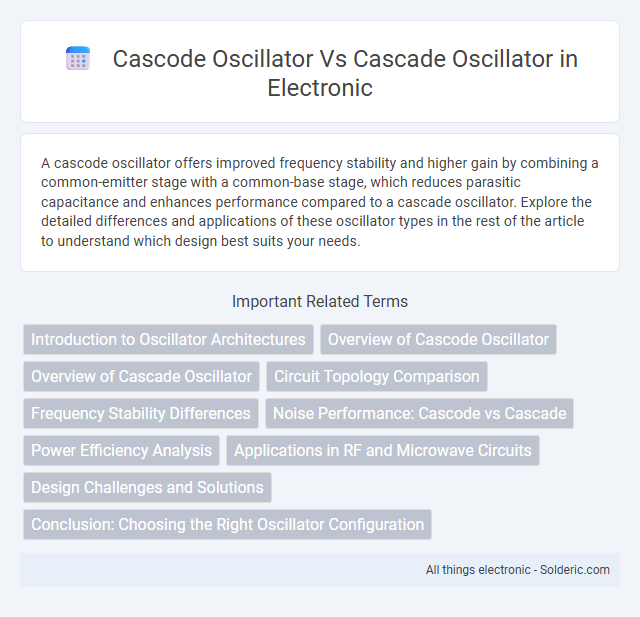A cascode oscillator offers improved frequency stability and higher gain by combining a common-emitter stage with a common-base stage, which reduces parasitic capacitance and enhances performance compared to a cascade oscillator. Explore the detailed differences and applications of these oscillator types in the rest of the article to understand which design best suits your needs.
Comparison Table
| Feature | Cascode Oscillator | Cascade Oscillator |
|---|---|---|
| Definition | Oscillator using a two-stage transistor configuration with a common-base stage stacked on a common-emitter stage. | Oscillator formed by connecting multiple stages of amplification or oscillator circuits in series. |
| Configuration | Two transistors arranged in cascode (common-emitter followed by common-base). | Multiple amplifier or oscillator stages cascaded sequentially. |
| Frequency Stability | High frequency stability due to reduced Miller effect and parasitic capacitance. | Depends on the individual stages; generally lower than cascode. |
| Gain | Moderate gain with improved bandwidth. | Higher gain possible by adding more stages, but with increased noise and potential instability. |
| Bandwidth | Wide bandwidth suitable for high-frequency oscillations. | Bandwidth reduces as more stages are cascaded due to cumulative phase shifts. |
| Complexity | Simple two-transistor design. | More complex due to multiple stages and interconnections. |
| Applications | High-frequency signal generation, RF circuits. | Low to mid-frequency oscillations, signal amplification chains. |
Introduction to Oscillator Architectures
Cascode oscillators employ a two-transistor configuration to enhance gain and frequency stability by reducing Miller capacitance, making them ideal for high-frequency applications. Cascade oscillators consist of multiple amplifier stages connected in series to achieve large overall gain, commonly used in low-frequency or audio circuits. Understanding these architectures is crucial for selecting oscillators that balance gain, bandwidth, and stability in RF and analog signal generation designs.
Overview of Cascode Oscillator
The cascode oscillator combines a common-emitter stage with a common-base stage to achieve high gain and improved frequency stability, making it ideal for high-frequency applications. Its configuration reduces parasitic capacitance and Miller effect, resulting in better performance compared to simpler oscillator designs. You can rely on a cascode oscillator for enhanced signal purity and reduced phase noise in RF circuits.
Overview of Cascade Oscillator
A cascade oscillator consists of multiple amplifier stages connected sequentially, each enhancing the overall gain to sustain oscillations. You can achieve higher output power and improved frequency stability as the signal passes through these cascaded amplifier stages. This configuration is commonly used in applications requiring robust signal amplification and precise frequency control.
Circuit Topology Comparison
Cascode oscillators integrate a common-emitter stage followed by a common-base stage, minimizing parasitic capacitance and enhancing frequency stability. Cascade oscillators, formed by sequential amplifier stages, primarily focus on gain enhancement but may introduce additional phase shifts affecting oscillation conditions. Your choice between cascode and cascade oscillator topologies depends on frequency performance requirements and stability in your specific circuit design.
Frequency Stability Differences
Cascode oscillators offer significantly improved frequency stability compared to cascade oscillators due to their reduced Miller capacitance and better isolation between input and output stages. This design minimizes feedback variations caused by transistor parameter changes and temperature fluctuations, ensuring a more consistent oscillation frequency. Your choice of oscillator circuit impacts the precision of frequency-dependent applications where stable signal generation is critical.
Noise Performance: Cascode vs Cascade
Cascode oscillators exhibit superior noise performance compared to cascade oscillators due to their inherent ability to reduce Miller capacitance and isolate the input from output, resulting in lower phase noise. The cascode configuration minimizes transistor leakage and improves overall gain stability, which enhances signal purity in sensitive RF applications. Your design will benefit from cascode oscillators when noise reduction is critical, offering more stable and cleaner oscillation than typical cascade arrangements.
Power Efficiency Analysis
The cascode oscillator exhibits higher power efficiency than the cascade oscillator due to its improved gain and reduced Miller effect, resulting in lower power consumption for the same output signal strength. The cascode configuration isolates input and output stages, minimizing parasitic capacitances and enhancing frequency stability, which contributes to more efficient power usage. In contrast, the cascade oscillator tends to consume more power because each amplification stage independently adds to the total power dissipation without significant isolation benefits.
Applications in RF and Microwave Circuits
Cascode oscillators are widely used in RF and microwave circuits for their high gain, improved frequency stability, and reduced Miller effect, making them ideal for low-noise, high-frequency applications such as wireless communication and radar systems. In contrast, cascade oscillators, formed by sequentially connecting multiple amplifier stages, are less favored in high-frequency RF applications due to increased noise and reduced stability but may be used in lower-frequency amplification where signal gain is prioritized over frequency precision. The cascode configuration's superior isolation and bandwidth characteristics make it essential in modern RF front-end design, whereas cascade oscillators find limited use in specific, low-frequency electronic signal processing tasks.
Design Challenges and Solutions
Cascode oscillators face design challenges such as managing parasitic capacitances and ensuring stable biasing to achieve high frequency performance, which are addressed by careful transistor stacking and advanced layout techniques to minimize signal loss and noise. Cascade oscillators struggle with phase distortion and gain stabilization across stages, often resolved through feedback control and optimized impedance matching to maintain consistent oscillation amplitude and low phase noise. Both oscillator types require precise component selection and thermal management strategies to enhance reliability and frequency stability in RF applications.
Conclusion: Choosing the Right Oscillator Configuration
The cascode oscillator offers superior frequency stability and higher gain by combining a common-emitter stage with a common-base stage, making it ideal for high-frequency applications. In contrast, the cascade oscillator, which stacks multiple amplifier stages, provides increased overall gain but may suffer from reduced stability and higher distortion. Selecting the right oscillator configuration depends on the specific requirements for frequency range, output amplitude, and signal purity in the intended electronic system.
cascode oscillator vs cascade oscillator Infographic

 solderic.com
solderic.com